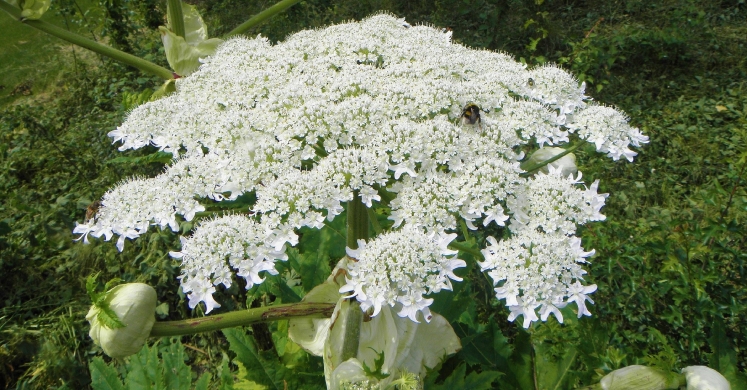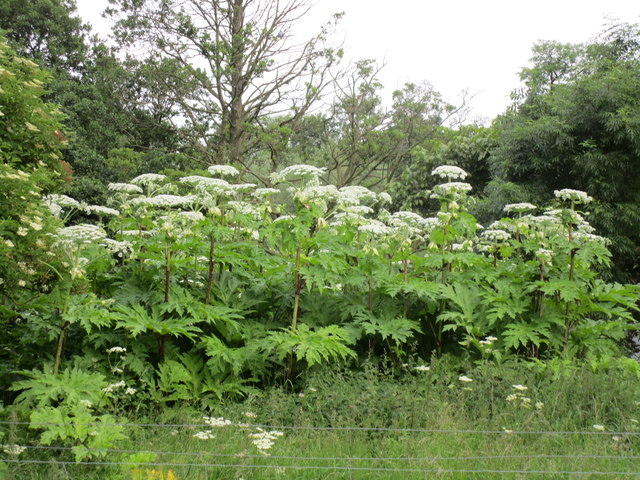Blog

#bioPGH Blog: Giant Hogweed
 A resource of Biophilia: Pittsburgh, #bioPGH is a weekly blog and social media series that aims to encourage both children and adults to reconnect with nature and enjoy what each of our distinctive seasons has to offer.
A resource of Biophilia: Pittsburgh, #bioPGH is a weekly blog and social media series that aims to encourage both children and adults to reconnect with nature and enjoy what each of our distinctive seasons has to offer.
It sounds like a plant straight out of the fantastical greenhouses of a magical school—a weed that grows extraordinarily tall; causes burns, blisters, and even blindness with its sap; and resists some conventional methods of removal. This is no magical Hogwarts plant, though—it is giant hogweed, an invasive plant introduced to Pennsylvania in the late 1990’s. It’s not currently present in Allegheny County, but since the noxious weed has been making a splash in headlines recently, let’s explore this a bit more.
Native to the Caucasus Mountains of Asia, giant hogweed was brought to the US in late nineteenth century and sold as ornamental until the early twentieth century. Superficially, hogweed might seem to add a little course texture and height to a landscape’s design: the plant itself can reach up to twenty feet tall, and its compound leaves can be five feet across (the leaf shape tends to change throughout the plant’s life cycle, as can be seen here). In addition, hogweed’s clusters of flowers look like a larger version of Queen Anne’s lace, adding a delicate edge to the imposing plant’s otherwise hardy appearance.
However, the plant has a distinct property that creates a challenge for humans: its sap. The sap of hogweed makes our skin highly sensitive to sunlight, causing the severe burns and blisters of phytophotodermatitis in very short periods of time (phyto meaning plant, photo meaning light, and dermatitis referring to a skin condition.) If sap is left exposed on our skin for even a matter of minutes, burns capable of deep tissue scarring can start to form; and that part of the skin can continue to be sensitive to sunlight long after the sap has been washed off and the original burns healed. If the sap is rubbed into eyes, it can cause temporary or even permanent blindness.
Given these scenarios, it’s unlikely any of us are still interested in hogweed as an ornamental! Unfortunately, the plant escaped cultivation long ago, and has spread to several states. So what can you do if you find it near your home, work or school? Hogweed is difficult to manage for a few different reasons. First is that its seeds are prolific. Each plant can create thousands of seeds per season, and those seeds can survive up to ten years. Second is that removing the actual plant is precarious work. Mowing or cutting back must be carried out multiple times to actually kill the plant, and this should only be done with the utmost of caution to avoid coming in contact with the plant’s sap—meaning covering any exposed skin and protecting the eyes. The safest form of removal is to contact the Pennsylvania Department of Agriculture to help you out:
“The state has an active program for controlling this plant,” says Trilby Libhart, state botanist for the department. “We will come spray or remove it, and then monitor it every year until it has been absent for 3 years. At that point we consider it eradicated.” For more information, you can check out their website or call the state’s noxious weed hotline at (877) 464-9333. You can also report hogweed directly to Libhart at tlibhart@pa.gov.
Of course, as with many other invasive plants, the best defense against giant hogweed is a good offense. Keep your green spaces filled with native plants and avoid disturbing the land when it’s not necessary (invasive plants are opportunistic and can take advantage of disturbed ground cover.) Pennsylvania’s DCNR has some added suggestions to prevent invasive plants. Happy planting!
Connecting to the Outdoors Tip: And if you’re thinking about what sustainable plants to fill your garden with, Phipps releases a new top ten list of sustainable plants every year. Be sure to check it out!
Continue the Conservation: Share your nature discoveries with our community by posting to Twitter and Instagram with hashtag #bioPGH, and R.S.V.P. to attend our next Biophilia: Pittsburgh meeting.

Resources
USA Today – Giant hogweed, a plant that can cause burns and blindness, was found in Virginia
CBS Pittsburgh – Toxic Plant That Can Cause Blindness Found in Pennsylvania
CBS News—8 Facts You Must Know About Giant Hogweed
Photo credit: Wikimedia Commons User Rob Hille CC-BY-SA-3.0, Jonathan Thacker CC-BY-SA-2.0

